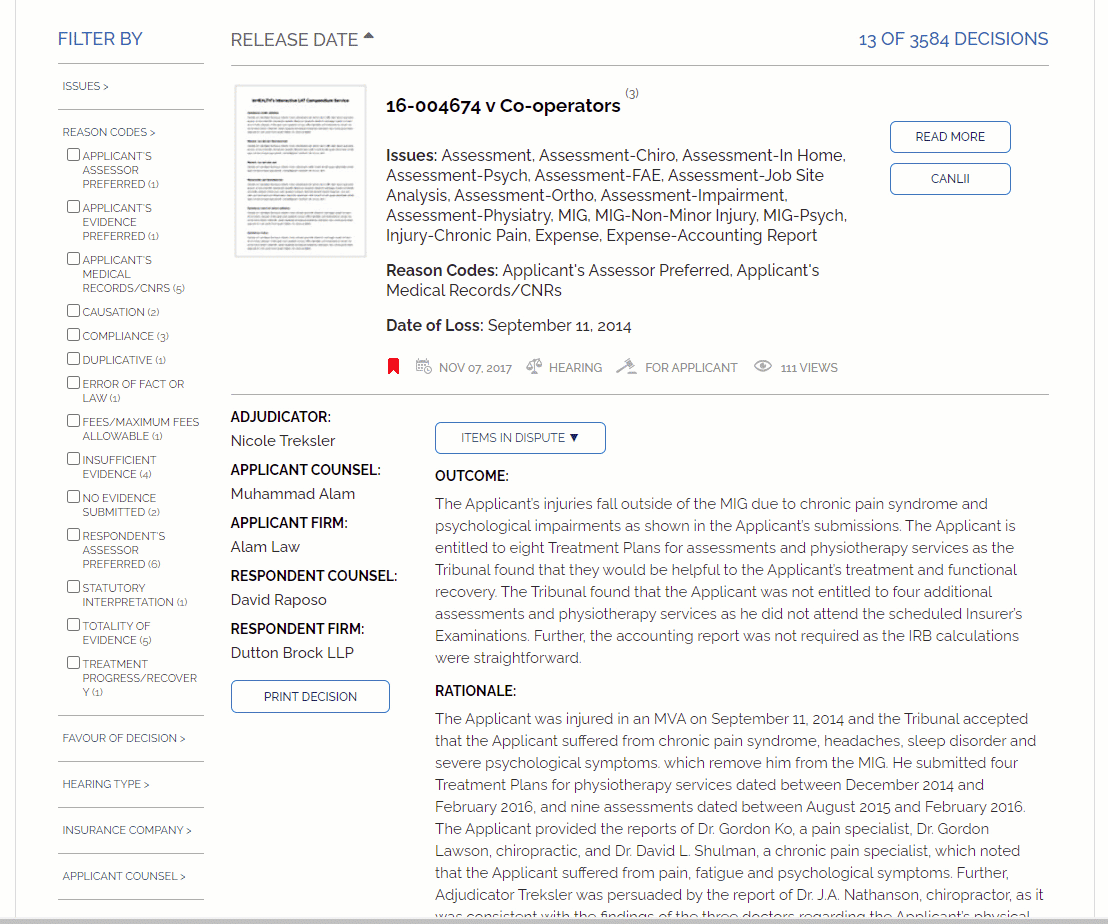
MIG Update – July 11, 2022
Two LAT Authorities Harmonious in Establishing Chronic Pain
In this week’s case, both the Applicant and Insurer relied on leading LAT decisions to advance their respective positions regarding a chronic pain diagnosis. The Tribunal found that both T.S. v. Aviva 17-000835 (cited 61 times) and 17-007825 v. Aviva (cited 47 times) can be read harmoniously and were persuasive in determining whether or not the Applicant suffered chronic pain as a result of the accident.
Reason Codes Are Here – Added Layer of Understanding!

Exciting News! Search and Filter by Reasons On inHEATH’s LAT Compendium
Reason codes add a deeper layer of understanding on the reason for the decision and associated issues in dispute. This added value is included in all subscription levels at no extra cost.
Try It Now!
Sign up for a 14 day free trial and book your walk-through with an inHEALTH team member by emailing service@inhealth.ca or send us a message through Live Chat!
Factor: Chronic Pain Syndrome & AMA Guides
In Halstead v. The Co-operators (20-002592), a March 5, 2018 accident, Halstead suffered with right lateral neck pain, left shoulder pain, and left hip pain and was diagnosed at the time with soft tissue injuries. X-rays of the neck and back revealed some degenerative changes. Halstead was off work until September 2018.
Halstead was seeking removal from the MIG on either pre-existing condition, psychological issues or chronic pain. He was ultimately removed from the MIG as the Tribunal found Halstead established on a balance of probabilities that he suffered with chronic pain syndrome.
Halstead relied on T.S. V Aviva (17-000835) where the Tribunal described chronic pain as “…ongoing or recurrent pain, lasting beyond the usual course of acute illness or injury or more than 3 to 6 months, and which adversely affects the individual’s well-being..”
On the other hand, The Co-operators submitted that Halstead’s neck pain, back pain, and shoulder pain fell within the Minor Injury definition. Further Halstead had failed to meet at least three of the six criteria required to meet the chronic pain diagnosis as set out in the AMA Guides adopted by the Tribunal in 17-007825 v. Aviva.
The Tribunal found:
- “In T.S. v. Aviva, the Tribunal’s description of chronic pain included adverse effects on an individual’s wellbeing and the six criteria set out in the AMA Guides can provide helpful guidance as an interpretive tool for understanding how pain is affecting the applicant’s functional capacity.”
- The records of the family doctor, Dr. Poon indicated that Halstead consistently sought medical attention for ongoing pain stemming from his physical injuries following the accident from 2018 to 2020.
- The Tribunal placed significant emphasis on Dr. Poon’s ongoing management and investigation.
- Dr. Poon had prescribed Baclofen and Arthrotec and ongoing physiotherapy that helped improve Halstead’s left shoulder and low back pain complaint while noting the pain was slightly better with the pain medication.
- Dr. Rozen’s chronic pain report October 2020 diagnosed Halstead with “chronic lumbar myofascial pain; aggravation of pre-existing lumbar degenerative disc disease, aggravation of pre-existing left shoulder osteoarthritis and chronic partial tear of the left supraspinatus tendon”.
- Dr. Rozen’s findings were consistent with the records of Dr. Poon in recording functional restrictions with housekeeping, work activities and social activities.
- Dr. Karabatsos IE October 2018 concluded that Halstead’s only impairment was in his left shoulder, which was contradictory to Dr. Poon’s CNRs.
- Dr. Rozen engaged with the criteria in the AMA Guides, which Dr. Karabatsos did not.
- The evidence of Dr. Poon and Dr. Rozen established that Halstead met 3 out of the 6 AMA Criterion namely;
- Secondary physical deconditioning due to disuse and/or fear-avoidance of physical activity due to pain
- Withdrawal from social milieu, including work, recreation, or other social contacts
- Failure to restore pre-injury function after a period of disability, such that the physical capacity is insufficient to pursue work, family or recreational needs
If you Have Read This Far…
Our MIG Monday series discusses the multitude of factors to consider when evaluating a risk position on MIG cases. The Tribunal has ruled on the MIG in 24% of the decisions so far. Each case is nuanced, but with similar factors.
Inform your position & present persuasive arguments. Include an Outcome Analysis Report (OAR) in your case evaluation complete with For/Against cases. Need an OAR?
inHEALTH Keeps you LAT inFORMED With Access To:
1. LAT Compendium Database – a relational database of LAT and Divisional Court Decisions equipped with multiple search options, Smart Filters, and concise case summaries
2. Notifications: – weekly LAT inFORMER delivered to your inbox Wednesdays; Newly Added Decisions on Fridays and Breaking News as and when it happens
3. Research Support: – inHEALTH’s Live Chat Experts for guided searches and technical inquiries.
Sign up for a 14 day free trial below to experience the service and see how it can help guide your decision making.
